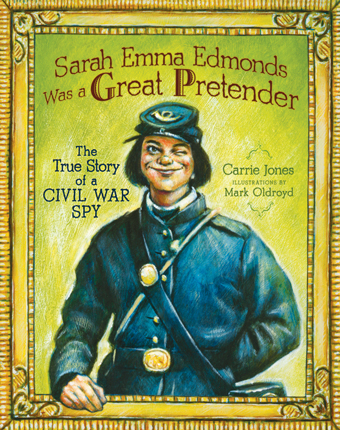Full Text Reviews: School Library Journal - 04/01/2011 Gr 1–4—The cover portraits cleverly introduce the book's topic. The front shows a person in a Civil War Union uniform, winking, with one hand hidden. The back presents a rear view of the same figure but now her fingers are shown to be crossed. Below the uniform, a skirt and parasol are displayed. As a teenager in the 1850s, Edmonds ran away from her abusive father and native Canada to come to the United States. Being on her own, she found it safer and easier to dress as a man. When the Civil War began, she is quoted as saying that patriotism was her primary impulse for enlisting in the Union army as "Frank Thompson," then working as a nurse and a spy. Her practice at pretending served her well as she once again changed her name and took on various new identities behind enemy lines. Using an informal, conversational style, Jones succeeds in keeping the complicated narrative at a level appropriate for young readers. Based on Edmonds's own writings as well as secondary sources, the book presents a believable account of the woman's actions. While some speculation is included as to her motivations, the text makes clear what is known and what is not. The illustrations portray Edmonds's feelings through her expressions and provide a visual context for readers. Employing a palette heavy on blues, yellows, and greens, with white outlining for emphasis, the pictures are impressionistic with realistic details. An unusual heroine, Edmonds will capture readers' attention.—Lucinda Snyder Whitehurst, St. Christopher's School, Richmond, VA - Copyright 2011 Publishers Weekly, Library Journal and/or School Library Journal used with permission. Booklist - 04/15/2011 This large-format picture book tells the remarkable story of Sarah Emma Edmonds, who grew up in Canada in the 1840s, raised by a father who mistreated her. Disguised as a boy, she ran away in her teens and supported herself by selling Bibles. When the Civil War began, she enlisted as a male nurse in the Union army. Later, she became a spy, passing on information gained when she disguised herself as a male slave, an Irish peddler woman, and an African American laundress. The portrayal of Sarah as a child, dressing as a boy in hopes of pleasing her father, will resonate with many readers, and the story of her later adventures is well worth telling. However, Jones overuses the words pretend and pretender in the text, making valid points but with little subtlety. The large-scale artwork offers dramatic scenes featuring Sarah in her many disguises. Accessible to younger children than most books on the Civil War, this would be a good addition to many collections. - Copyright 2011 Booklist. Bulletin for the Center... - 05/01/2011 It’s a generally accepted fact that many women passed as men on Civil War battlefields, but the condition of secrecy, of course, rendered their stories untold. Much is known, though, about Sarah Edmonds, a young Canadian woman who enlisted in the Michigan Volunteer Infantry under the name of Frank Thompson. Serving first as a battlefield nurse, Sarah/Frank was recruited for espionage missions behind Confederate lines. Her spying days came to an end with a bout of malaria; unwilling to risk revealing her identity in a military hospital, she sought civilian medical attention instead. By the time “Sarah” had recovered, “Frank” was listed as a deserter, forcing Edmonds to retire from soldiering. Jones and Moss have sometimes conflicting, sometimes complementary takes on Edmonds’ story. Moss has her initially fleeing from an arranged marriage, and Jones from an abusive father. Moss emphasizes her nursing role and one mission as a spy; Jones discusses several of her disguises on various spy missions. Each title has a distinctive look: the jazzed-up folksiness of Hendrix’s pictures in Nurse and Oldroyd’s hazily atmospheric illustrations in Sarah. In a battle of the books, Nurse ?has a slight edge with snappier storytelling, a substantial historical note, remarks on the artist’s research, a glossary of Civil War terms, bibliographies, and an index, and even a pair of photographs of Edmonds and “Thompson.” There’s a pragmatic simplicity to Jones’ text, though, and she weighs in additionally with the “Thompson” photo, a brief note, and a briefer bibliography. EB - Copyright 2011 The Board of Trustees of the University of Illinois. Loading...
|



